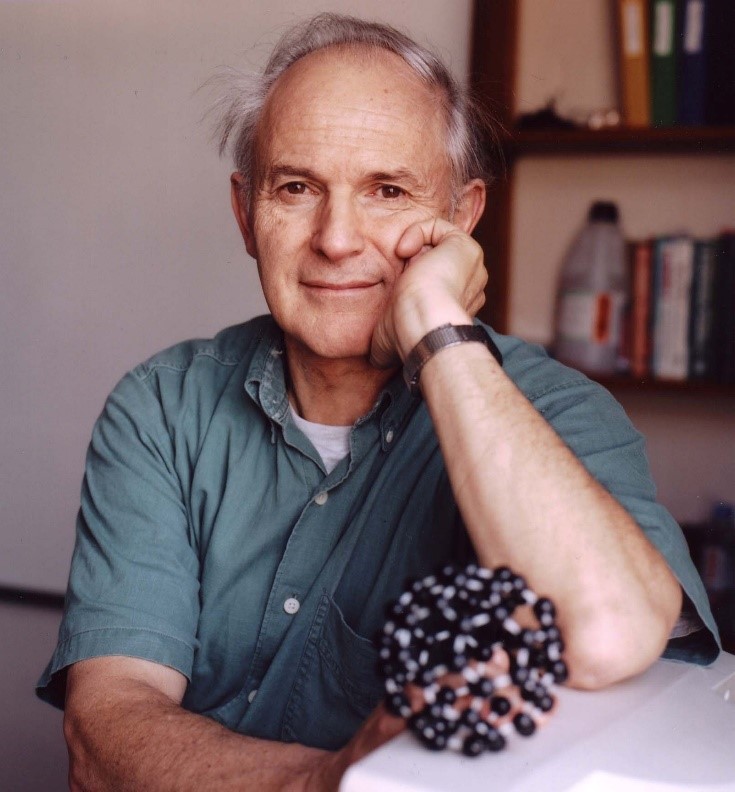About Harry

Sir Harold Kroto joined the faculty at FSU in 2004 as the Francis Eppes Professor of Chemistry after spending a large part of his career at the University of Sussex, in England. In 1996, Harry shared the Nobel Prize in Chemistry with Robert Curl and Richard Smalley for their discovery of fullerenes, a novel allotrope of carbon. He is one of only six Nobelists to have been on the Faculty at Florida State University.
Harry enrolled in the University of Sheffield in 1958 as an undergraduate, and earned a doctorate degree in Molecular Spectroscopy from that University in 1964. Harry’s University experience reflected his broad interests and especially his interest in the arts, athletics, and music. He served as the art editor for the University’s student magazine, played what today would be considered inter-collegiate tennis, and was president of the Student Athletics Council.
Harry’s dissertation work can be classified as organic chemistry and it was during this period that he developed an interest in molecules containing chains of carbon atoms connected by multiple bonds. His initial work involved the chemical synthesis of these and other classes of molecules but he quickly became interested in their spectroscopic characterization, leading him to a lifelong interest in molecular structure and quantum mechanics. His interest in these exotic molecular species lead to research on long linear chains of carbon-rich molecules, which were known to be at relatively high abundance in interstellar space and in the outer atmosphere of some stars, called red giants. A critical aspect of this work was to determine possible mechanisms for their synthesis under conditions that were thought to mimic the atmosphere of red-giant stars. It was this interest that lead to the collaboration with Smalley and Curl. In these experiments, graphite, which are flat sheets of carbon atoms connected by multiple bonds, was excited to very high energies and temperatures using lasers. The molecules that were created by this process were characterized by mass spectrometry and other methods. Under these conditions, the mass spectrum showed the presence of a dominant product with a mass of 720 daltons that was composed only of carbon atoms.
Harry struggled to propose a structure of this molecule because all previous molecules also contained oxygen, hydrogen or other elements. Principles of chemical bonding constrained the possible structures that could be imagined. Harry’s interest in art lead him to propose a structure analogous to the geodesic domes designed by Buckminster Fuller, which consisted of 60 apices, forming a mixture of 5-membered (pentagons) and 6-membered (hexagons) in the shape of a soccer ball. He named the molecule “buckminsterfullere”, but they quickly came to be called “bucky balls”. Although contentious when first proposed, subsequent work quickly confirmed the closed, carbon-only structure. Studies on how these molecules were formed upon laser excitation of graphene lead to the identification of nanotubes and other molecules in widespread use today. Harry continued his research at Florida State, pursuing a variety of projects in collaboration with Alan Marshall and Naresh Dalal.
In addition to his interests in chemistry, Harry was deeply committed to humanism and to science education. He established the Vega Science Trust, which created high quality videos and films of lectures and interviews with leading scientists of the day, including a large number of Nobel prize winners. This material was made available to the public and served as a video Wikipedia or streaming TV channel containing over 280 films. At Florida State, Harry created GEOSET, short for Global Educational Outreach for Science, Education, and Technology, a publically viewable database and repository of science videos. Importantly, the focus was less on “experts” and more on “afficonados” of science – including undergraduate and graduate students. Harry used his fame as a Nobelist to travel the world and lecture on humanism and the importance of critical thought, given here at FSU in his wildly successful lecture series titled “Five Days of Opening Minds”. He introduced thousands of young (and young at heart) people around the world to the wonders and accomplishments of science through his “buckyball workshops”. His FSU lectures were characterized by a challenge to individual beliefs and a call to responsibility, sprinkled with his incredible wit and sense of humor.
In recognition of Harry’s many scientific and humanitarian accomplishments, the University of Sussex has named two buildings after Harry Kroto. We feel that naming the Chemistry auditorium in his honor is one way to memorialize and recognize his time here at FSU.
